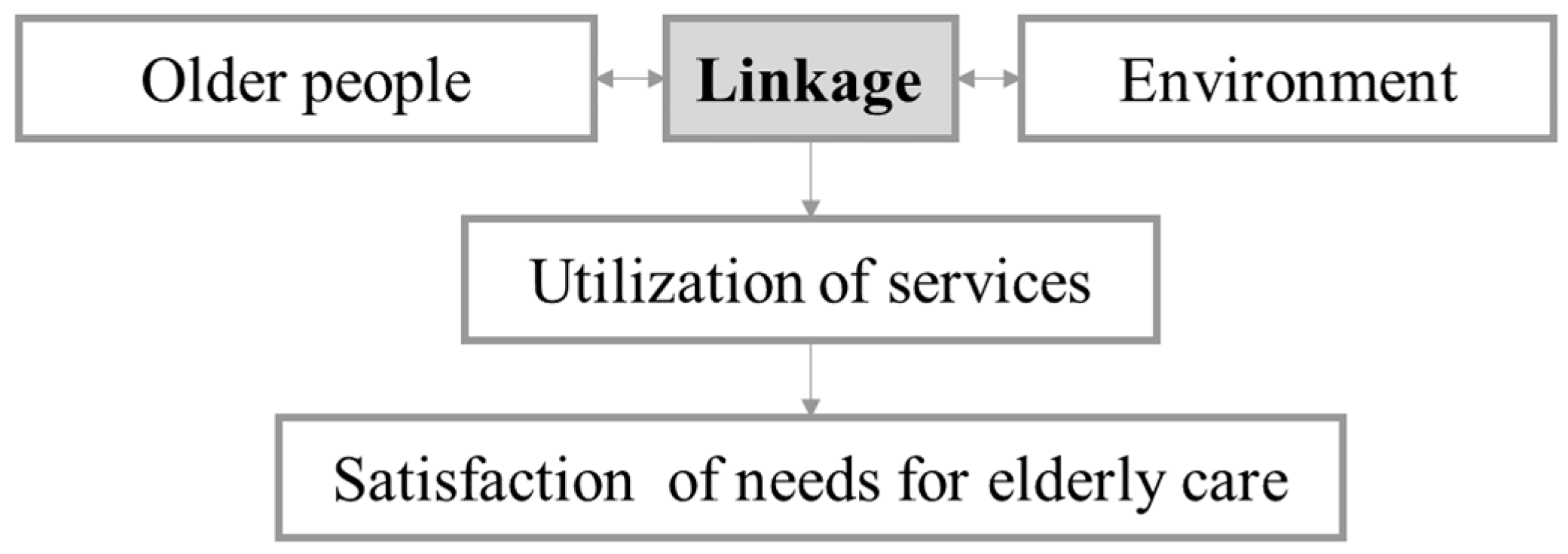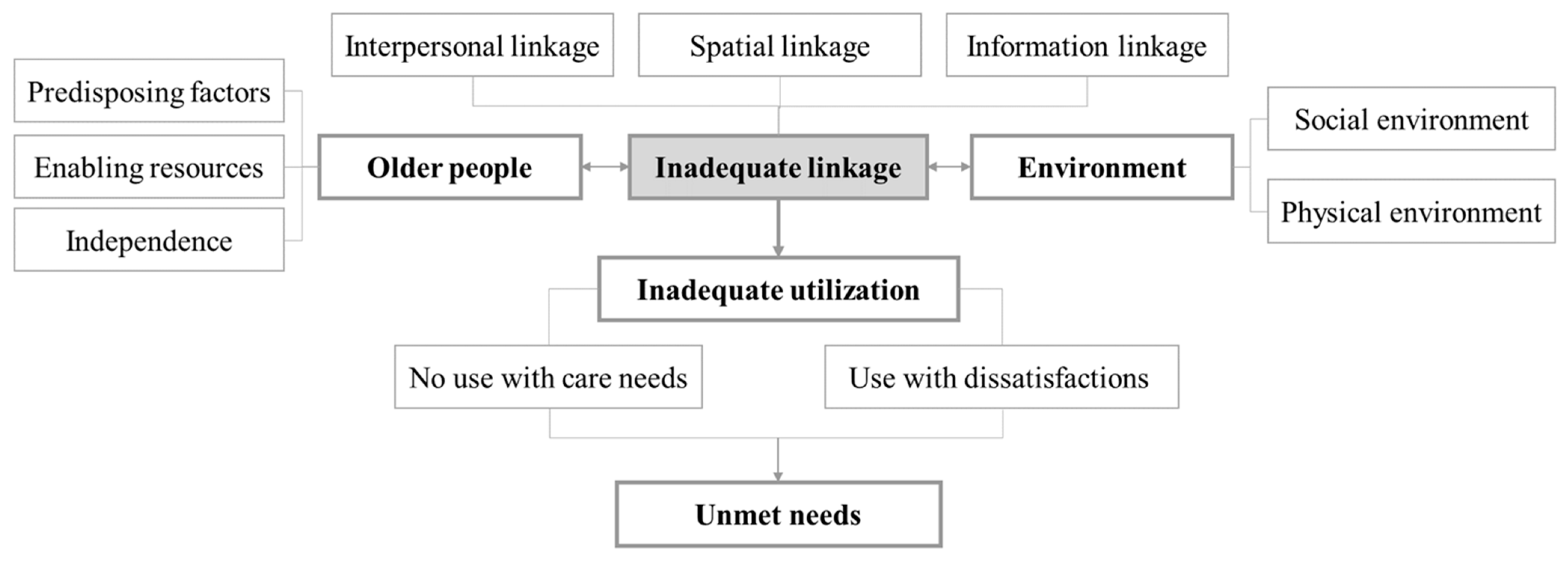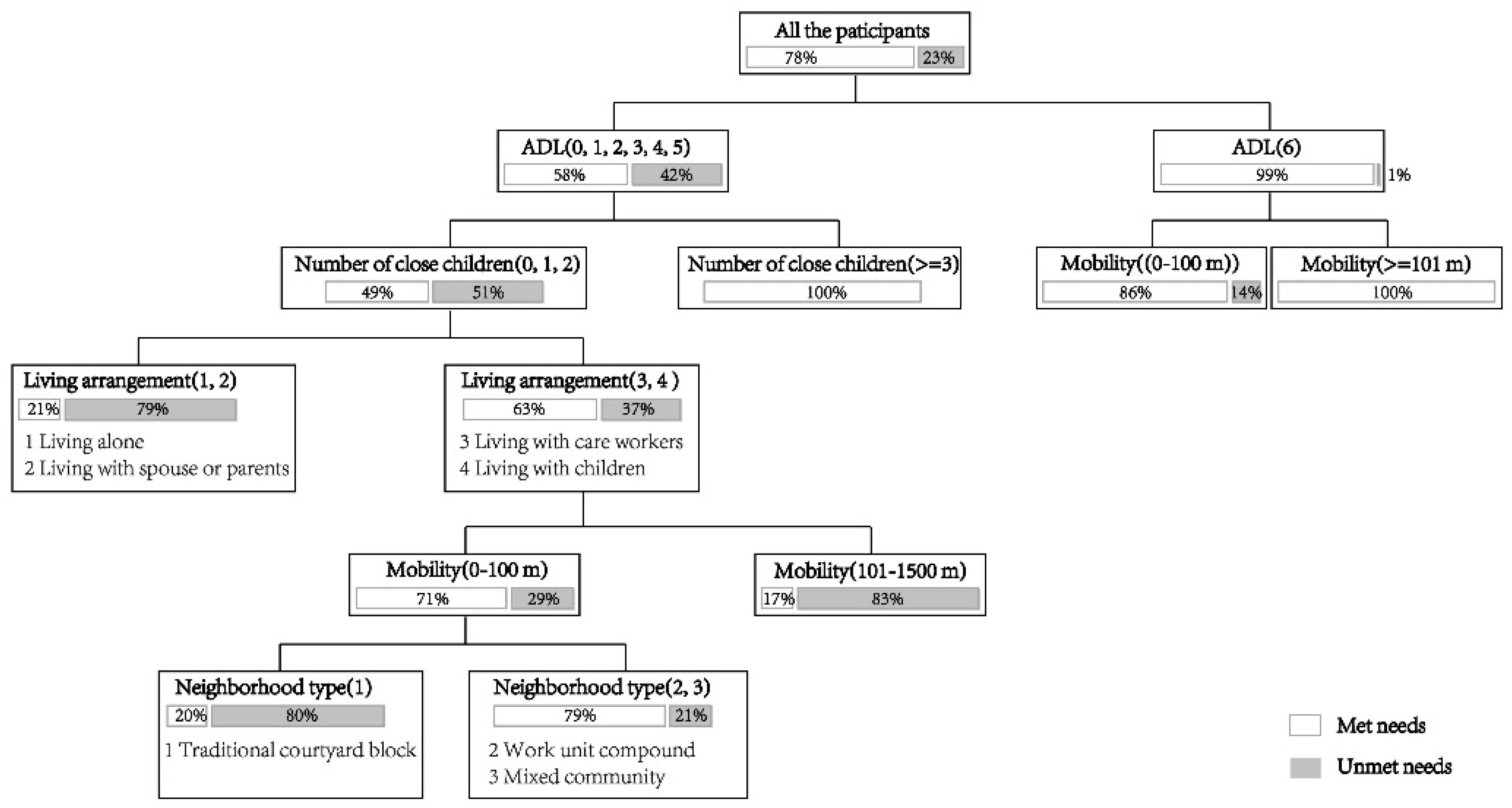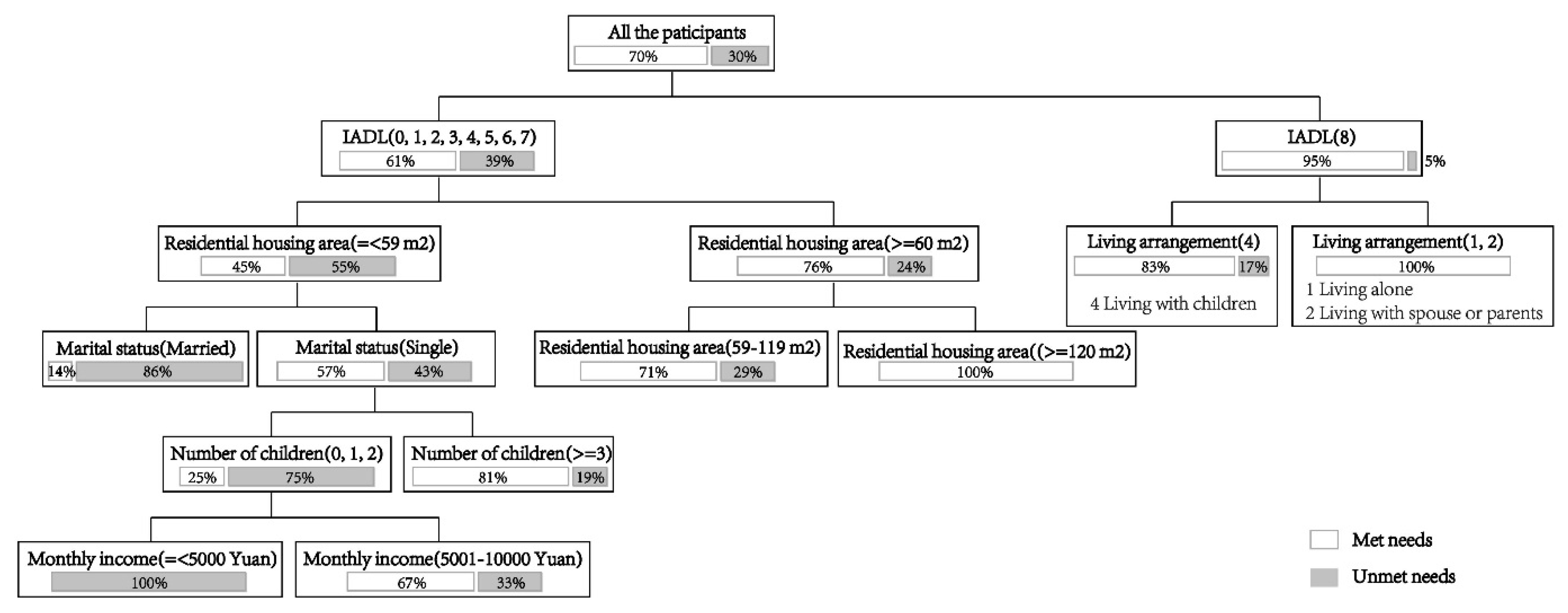Understanding the Unmet Needs among Community-Dwelling Disabled Older People from a Linkage Perspective
Abstract
1. Introduction
2. Conceptual Framework
2.1. Limitations in the Literature
2.2. Key Concepts in the Elderly Care Utilization Context
2.3. A New Framework
3. Materials and Methods
3.1. Data
3.2. Ethics
3.3. Dependent Variables
3.4. Independent Variables
3.5. Statistical Analysis
4. Results
4.1. Prevalence of Unmet Needs
4.2. Factors Influencing Unmet Needs for ADL Assistance
4.3. Factors Influencing Unmet Needs for IADL Assistance
5. Discussion
5.1. Individual Ability and the Environment
5.2. Mobility and Access to Elderly Care
5.3. Linkage in the Care Delivery for Disabled Older People
6. Conclusions
Author Contributions
Funding
Institutional Review Board Statement
Informed Consent Statement
Acknowledgments
Conflicts of Interest
References
- Iparraguirre, J.L. Reductions in local government spending on community-based social care and unmet social care needs of older people in England. J. Econ. Ageing 2017, 100126. [Google Scholar] [CrossRef]
- Hass, Z.; DePalma, G.; Craig, B.A.; Xu, H.; Sands, L.P. Unmet need for help with activities of daily living disabilities and emergency department admissions among older medicare recipients. Gerontologist 2017, 57, 206–210. [Google Scholar] [CrossRef] [PubMed]
- Krůtilová, V. Unmet need for health care—A serious issue for european elderly? Procedia Soc. Behav. Sci. 2016, 220, 217–225. [Google Scholar] [CrossRef]
- Means, R. A brave new world of personalized care? Historical perspectives on social care and older people in England. Soc. Policy Adm. 2012, 46, 302–320. [Google Scholar] [CrossRef]
- Zhu, Y.; Osterle, A. Rural-urban disparities in unmet long-term care needs in China: The role of the hukou status. Soc. Sci. Med. 2017, 191, 30–37. [Google Scholar] [CrossRef]
- Momtaz, Y.A.; Hamid, T.A.; Ibrahim, R. Unmet needs among disabled elderly Malaysians. Soc. Sci. Med. 2012, 75, 859–863. [Google Scholar] [CrossRef] [PubMed]
- Charlesworth, S. Long-term care reforms in OECD countries. Ageing Soc. 2017, 37, 1527–1529. [Google Scholar] [CrossRef]
- Pavolini, E.; Ranci, C. Restructuring the welfare state: Reforms in long-term care in Western European countries. J. Eur. Soc. Policy 2008, 18, 246–259. [Google Scholar] [CrossRef]
- Joseph, A.E.; Kearns, R.A. Deinstitutionalization meets restructuring: The closure of a psychiatric hospital in New Zealand. Health Place 1996, 2, 179–189. [Google Scholar] [CrossRef]
- Borup, J.H. The effects of varying degrees of interinstitutional environmental change on long-term care patients. Gerontologist 1982, 22, 409–417. [Google Scholar] [CrossRef]
- Joseph, A.E.; Chalmers, A.I.L. Restructuring long-term care and the geography of ageing: A view from rural New Zealand. Soc. Sci. Med. 1996, 42, 887–896. [Google Scholar] [CrossRef]
- Castle, N.G. Relocation of the elderly. Med. Care Res. Rev. MCRR 2001, 58, 291. [Google Scholar] [CrossRef] [PubMed]
- Williams, A.M. Restructuring home care in the 1990s: Geographical differentiation in Ontario, Canada. Health Place 2006, 12, 222–238. [Google Scholar] [CrossRef] [PubMed]
- Garcia-Gomez, P.; Hernandez-Quevedo, C.; Jimenez-Rubio, D.; Oliva-Moreno, J. Inequity in long-term care use and unmet need: Two sides of the same coin. J. Health Econ. 2015, 39, 147–158. [Google Scholar] [CrossRef]
- Bødker, M.N.; Christensen, U.; Langstrup, H. Home care as reablement or enabling arrangements? An exploration of the precarious dependencies in living with functional decline. Sociol. Health Illn. 2019, 41, 1358–1372. [Google Scholar] [CrossRef]
- Cho, S.E. Determinants of health care service utilization in people with developmental disabilities: An application of the Gelberg-Andersen behavioral model for vulnerable populations. J. Appl. Res. Intellect. 2014, 27, 354. [Google Scholar]
- Beach, S.R.; Schulz, R. Family caregiver factors associated with unmet needs for care of older adults. J. Am. Geriatr. Soc. 2017, 65, 560–566. [Google Scholar] [CrossRef]
- Newcomer, R.; Kang, T.; Laplante, M.; Kaye, S. Living quarters and unmet need for personal care assistance among adults with disabilities. J. Gerontol. Ser. B Psychol. Sci. Soc. Sci. 2005, 60, S205–S213. [Google Scholar] [CrossRef]
- Heider, D.; Matschinger, H.; Muller, H.; Saum, K.U.; Quinzler, R.; Haefeli, W.E.; Wild, B.; Lehnert, T.; Brenner, H.; Konig, H.H. Health care costs in the elderly in Germany: An analysis applying Andersen’s behavioral model of health care utilization. BMC Health Serv. Res. 2014, 14, 71. [Google Scholar] [CrossRef]
- Andersen, R.; Newman, J.F. Societal and individual determinants of medical care utilization in the United States. Milbank Meml. Fund Q. Health Soc. 1973, 51, 95–124. [Google Scholar] [CrossRef]
- Yu, J.; Rosenberg, M.W. “No place like home”: Aging in post-reform Beijing.pdf. Health Place 2017, 46, 192–200. [Google Scholar] [CrossRef] [PubMed]
- Yu, J.; Rosenberg, M.W. Aging and the changing urban environment: The relationship between older people and the living environment in post-reform Beijing, China. Urban Geogr. 2020, 41, 162–181. [Google Scholar] [CrossRef]
- Engel, L.; Chudyk, A.M.; Ashe, M.C.; McKay, H.A.; Whitehurst, D.G.T.; Bryan, S. Older adults’ quality of life—Exploring the role of the built environment and social cohesion in community-dwelling seniors on low income. Soc. Sci. Med. 2016, 164, 1–11. [Google Scholar] [CrossRef]
- Eronen, J.; von Bonsdorff, M.B.; Törmäkangas, T.; Rantakokko, M.; Portegijs, E.; Viljanen, A.; Rantanen, T. Barriers to outdoor physical activity and unmet physical activity need in older adults. Prev. Med. 2014, 67, 106–111. [Google Scholar] [CrossRef] [PubMed]
- Larsson, K.; Thorslund, M.; Kåreholt, I. Are public care and services for older people targeted according to need? Applying the Behavioural Model on longitudinal data of a Swedish urban older population. Eur. J. Ageing 2006, 3, 22–33. [Google Scholar] [CrossRef][Green Version]
- Andersen, R.M. National health surveys and the behavioral model of health services use. Med. Care 2008, 7, 647–653. [Google Scholar] [CrossRef]
- Andersen, R.M. Revisiting the behavioral model and access to medical care: Does it matter? J. Health Soc. Behav. 1995, 36, 1–10. [Google Scholar] [CrossRef]
- Pill, R. Accessibility and utilization: Geographical perspectives on health care delivery. J. R. Coll. Gen. Pract. 1984, 34, 452. [Google Scholar]
- Mohan, G.; Nolan, A.; Lyons, S. An investigation of the effect of accessibility to General Practitioner services on healthcare utilisation among older people. Soc. Sci. Med. 2019, 220, 254–263. [Google Scholar] [CrossRef]
- Padeiro, M. Geographical accessibility to community pharmacies by the elderly in metropolitan Lisbon. Res. Soc. Adm. Pharm. 2018, 14, 653–662. [Google Scholar] [CrossRef]
- WHO. World Report on Ageing and Health; WHO: Geneva, Switzerland, 2015. [Google Scholar]
- Phillips, J.; Walford, N.; Hockey, A.; Foreman, N.; Lewis, M. Older people and outdoor environments: Pedestrian anxieties and barriers in the use of familiar and unfamiliar spaces. Geoforum 2013, 47, 113–124. [Google Scholar] [CrossRef]
- Golant, S.M. Affordable clustered housing-care: A category of long-term care options for the elderly poor. J. Hous. Elder. 2008, 22, 3–44. [Google Scholar] [CrossRef]
- Lagergren, M.; Sjolund, B.M.; Fagerstrom, C.; Berglund, J.; Fratiglioni, L.; Nordell, E.; Wimo, A.; Elmstahl, S. Horizontal and vertical target efficiency—A comparison between users and non-users of public long-term care in Sweden. Ageing Soc. 2014, 34, 700–719. [Google Scholar] [CrossRef]
- Rosenberg, M.W.; Hanlon, N.T. Access and utilization: A continuum of health service environments. Soc. Sci. Med. 1996, 43, 975–983. [Google Scholar] [CrossRef]
- Weissert, W.G. Seven reasons why it is so difficult to make community-based long-term care cost-effective. Health Serv. Res. 1985, 20, 423–433. [Google Scholar] [PubMed]
- Bigby, C. Access and linkage: Two critical issues for older people with an intellectual disability in utilising day activity and leisure services. Aust. N. Z. J. Dev. Disabil. 1992, 18, 95–109. [Google Scholar] [CrossRef]
- Lawton, M.P.; Nahemow, L. Ecology and the aging process. Psychol. Adult Dev. Aging 1973, 619–674. [Google Scholar] [CrossRef]
- Beijing Working Committee on Aging Office; Beijing Association for the Aged; China Public Welfare Research Institute; Beijing Normal University. Report on the Development of Undertakings for the Aged in Beijing (2018); Social Science Academic Press, Ed.; Social Science Academic Press: Beijing, China, 2019. [Google Scholar]
- Allen, S.M.; Mor, V. The prevalence and consequences of unmet need. Contrasts between older and younger adults with disability. Med. Care 1997, 35, 1132–1148. [Google Scholar] [CrossRef]
- Chen, S.; Zheng, J.; Chen, C.; Xing, Y.; Cui, Y.; Ding, Y.; Li, X. Unmet needs of activities of daily living among a community-based sample of disabled elderly people in Eastern China: A cross-sectional study. BMC Geriatr. 2018, 18, 160. [Google Scholar] [CrossRef]
- Katz, S.; Ford, A.B.; Moskowitz, R.W.; Jackson, B.A.; Jaffe, M.W. Studies of illness in the aged. the index of ADL: A standardized measure of biological and psychosocial function. JAMA 1963, 185, 914–919. [Google Scholar] [CrossRef]
- Lawton, M.P.; Brody, E.M. Assessment of older people: Self-maintaining and instrumental activities of daily living. Gerontologist 1969, 9, 179–186. [Google Scholar] [CrossRef] [PubMed]
- Song, Y.-Y.; Lu, Y. Decision tree methods: Applications for classification and prediction. Shanghai Arch. Psychiatry 2015, 27, 130–135. [Google Scholar] [CrossRef] [PubMed]
- Bae, J.N.; Cho, M.J. Development of the Korean version of the Geriatric Depression Scale and its short form among elderly psychiatric patients. J. Psychosom. Res. 2004, 57, 297–305. [Google Scholar] [CrossRef]
- Rotarou, E.S.; Sakellariou, D. Access to health care in an age of austerity: Disabled people’s unmet needs in Greece. Crit. Public Health 2019, 29, 48–60. [Google Scholar] [CrossRef]
- Bien, B.; McKee, K.J.; Dohner, H.; Triantafillou, J.; Lamura, G.; Doroszkiewicz, H.; Krevers, B.; Kofahl, C. Disabled older people’s use of health and social care services and their unmet care needs in six European countries. Eur. J. Public Health 2013, 23, 1032–1038. [Google Scholar] [CrossRef]
- Kuzuya, M.; Hirakawa, Y.; Suzuki, Y.; Iwata, M.; Enoki, H.; Hasegawa, J.; Iguchi, A. Association between unmet needs for medication support and all-cause hospitalization in community-dwelling disabled elderly people. J. Am. Geriatr. Soc. 2008, 56, 881–886. [Google Scholar] [CrossRef]
- Katz, S.; Downs, T.D.; Cash, H.R.; Grotz, R.C. Progress in development of index of ADL. Gerontologist 1970, 10, 20–30. [Google Scholar] [CrossRef]
- Wallace, M.S.M. Katz Index of Independence in Activities of Daily Living. Available online: www.ConsultGeriRN.org (accessed on 3 November 2020).
- Casado, B.L.; van Vulpen, K.S.; Davis, S.L. Unmet needs for home and community-based services among frail older americans and their caregivers. J. Aging Health 2011, 23, 529–553. [Google Scholar] [CrossRef]
- Desai, M.M.; Lentzner, H.R.; Weeks, J.D. Unmet need for personal assistance with activities of daily living among older adults. Gerontologist 2001, 41, 82–88. [Google Scholar] [CrossRef]
- Casey, R. Disability and unmet health care needs in Canada: A longitudinal analysis. Disabil. Health J. 2015, 8, 173–181. [Google Scholar] [CrossRef]
- Gelberg, L.; Andersen, R.M.; Leake, B.D. The behavioral model for vulnerable populations: Application to medical care use and outcomes for homeless people. Health Serv. Res. 2000, 34, 1273–1302. [Google Scholar] [PubMed]





| Factors | Variables | Level | Proportion | |
|---|---|---|---|---|
| Personal attributes of older people | Predisposing factors | Age | 60–69 | 9% |
| 70–79 | 25% | |||
| 80–89 | 47% | |||
| >=90 | 19% | |||
| Gender | Male | 35% | ||
| Female | 65% | |||
| Marital status | Married | 39% | ||
| Single (unmarried/divorced/widowed) | 61% | |||
| Educational background | Elementary school and below | 41% | ||
| Middle school | 27% | |||
| High school | 14% | |||
| Junior College and above | 18% | |||
| Enabling resources | Monthly income (Yuan) | <2000 | 7% | |
| 2001–5000 | 29% | |||
| 5001–10,000 | 34% | |||
| >10,000 | 30% | |||
| The number of children | 0 | 9% | ||
| 1 | 19% | |||
| 2 | 33% | |||
| >=3 | 39% | |||
| Internet utilization | Good | 9% | ||
| Fair | 14% | |||
| Poor | 77% | |||
| Independence | ADL | 0–1 | 18% | |
| 2–3 | 10% | |||
| 4–5 | 24% | |||
| 6 | 48% | |||
| IADL | 0–1 | 29% | ||
| 2–4 | 25% | |||
| 5–7 | 19% | |||
| 8 | 27% | |||
| Mobility (meters) | 0–100 | 47% | ||
| 101–500 | 26% | |||
| 501–1500 | 12% | |||
| >1500 | 14% | |||
| Environments characteristics | Social environment | Neighborhood type | Traditional courtyard block | 32% |
| Work unit compound | 29% | |||
| Mixed community | 39% | |||
| Physical environment | Density of community facilities (per square kilometer) | Elderly care facilities for ADL model | ||
| Retail outlets for IADL model | ||||
| Residential housing area (square meters) | =<59 | 47% | ||
| 60–99 | 27% | |||
| 100–119 | 14% | |||
| >120 | 12% | |||
| Linkage | Interpersonal linkage | Living arrangement | Living alone | 22% |
| Living with spouse or parents | 24% | |||
| Living with care workers | 14% | |||
| Living with children | 40% | |||
| The number of close children | 0 | 25% | ||
| 1 | 38% | |||
| 2 | 22% | |||
| >=3 | 15% | |||
| The number of close friend | 0 | 38% | ||
| 1 | 13% | |||
| 2 | 17% | |||
| >=3 | 32% | |||
| Spatial linkage | Distance of the nearest facilities (meters) | Elderly care facilities for ADL model | ||
| Retail outlets for IADL model | ||||
| Distance of the nearest children (meters) | >=0 | 63% | ||
| No children | 7% | |||
| Information linkage | Service hotline utilization | Good | 7% | |
| Fair | 31% | |||
| Poor | 62% | |||
| IADL | |||
|---|---|---|---|
| Met Needs | Unmet Needs | ||
| ADL | Met needs | 63.31% | 14.38% |
| Unmet needs | 6.47% | 15.83% | |
| Unmet Needs for ADL | Unmet Needs for IADL | |
|---|---|---|
| disabled older people | 41.67% | 40.28% |
| non-disabled older people | 1.49% | 19.40% |
Publisher’s Note: MDPI stays neutral with regard to jurisdictional claims in published maps and institutional affiliations. |
© 2021 by the authors. Licensee MDPI, Basel, Switzerland. This article is an open access article distributed under the terms and conditions of the Creative Commons Attribution (CC BY) license (http://creativecommons.org/licenses/by/4.0/).
Share and Cite
Wu, D.; Gao, X.; Xie, Z.; Xu, Z. Understanding the Unmet Needs among Community-Dwelling Disabled Older People from a Linkage Perspective. Int. J. Environ. Res. Public Health 2021, 18, 389. https://doi.org/10.3390/ijerph18020389
Wu D, Gao X, Xie Z, Xu Z. Understanding the Unmet Needs among Community-Dwelling Disabled Older People from a Linkage Perspective. International Journal of Environmental Research and Public Health. 2021; 18(2):389. https://doi.org/10.3390/ijerph18020389
Chicago/Turabian StyleWu, Danxian, Xiaolu Gao, Zhifei Xie, and Zening Xu. 2021. "Understanding the Unmet Needs among Community-Dwelling Disabled Older People from a Linkage Perspective" International Journal of Environmental Research and Public Health 18, no. 2: 389. https://doi.org/10.3390/ijerph18020389
APA StyleWu, D., Gao, X., Xie, Z., & Xu, Z. (2021). Understanding the Unmet Needs among Community-Dwelling Disabled Older People from a Linkage Perspective. International Journal of Environmental Research and Public Health, 18(2), 389. https://doi.org/10.3390/ijerph18020389





